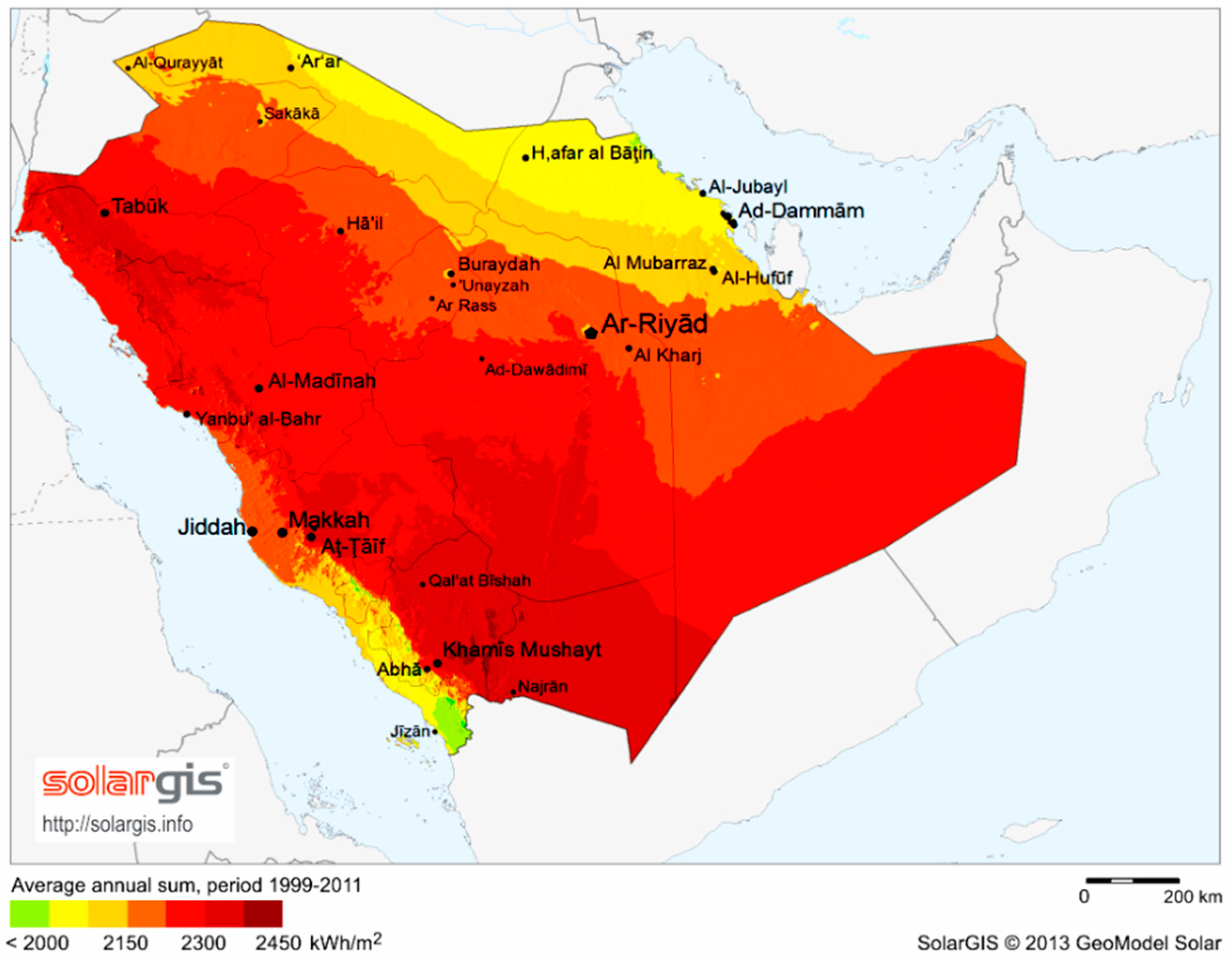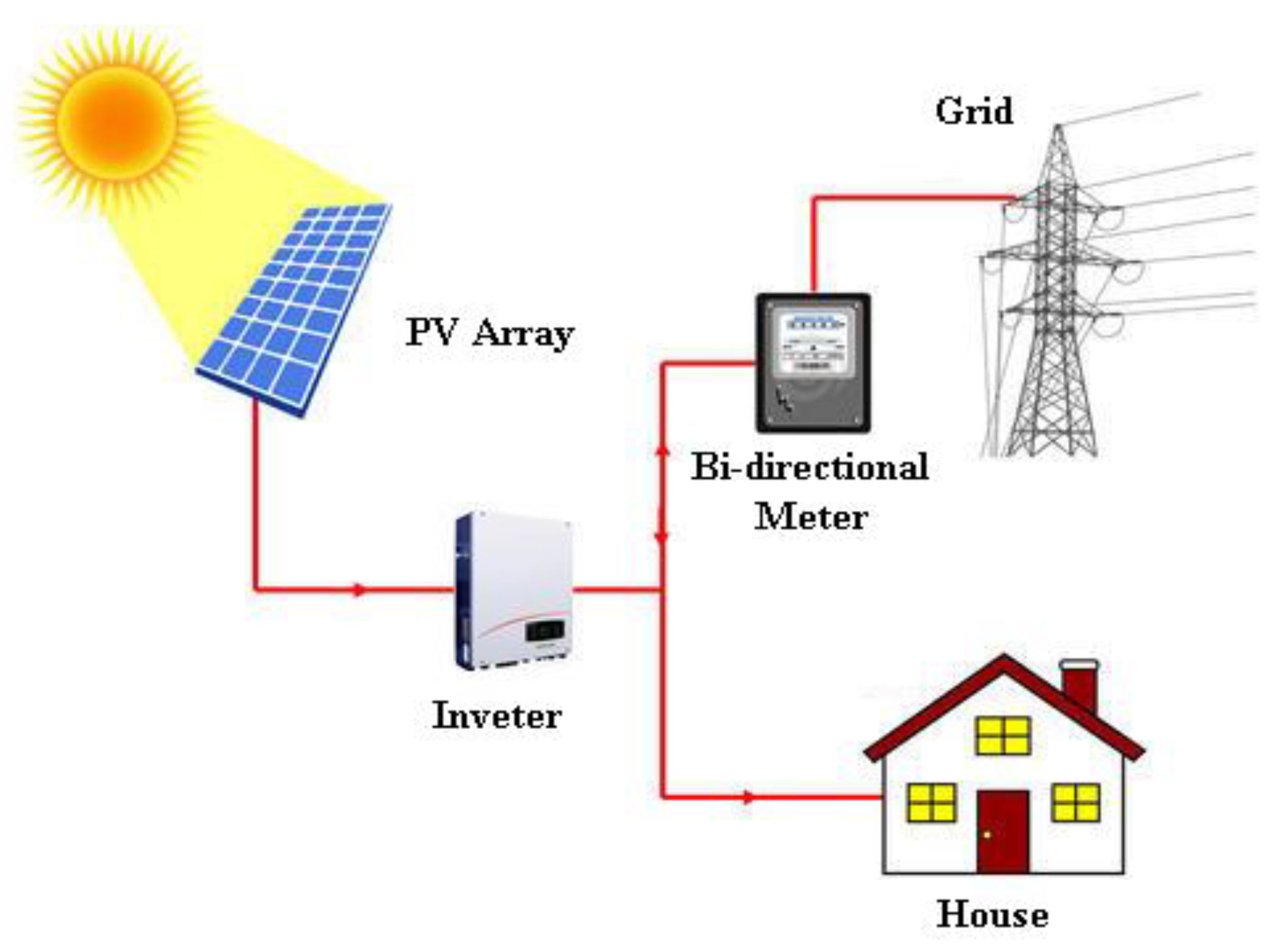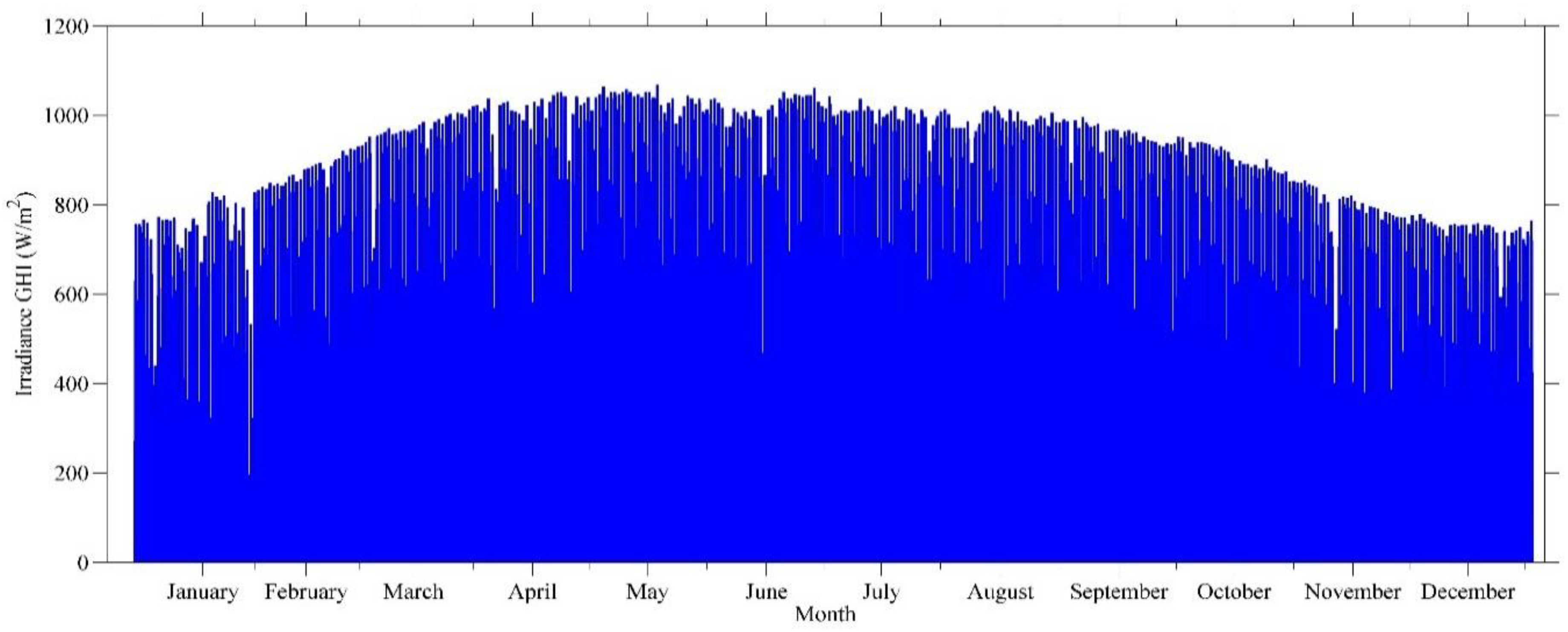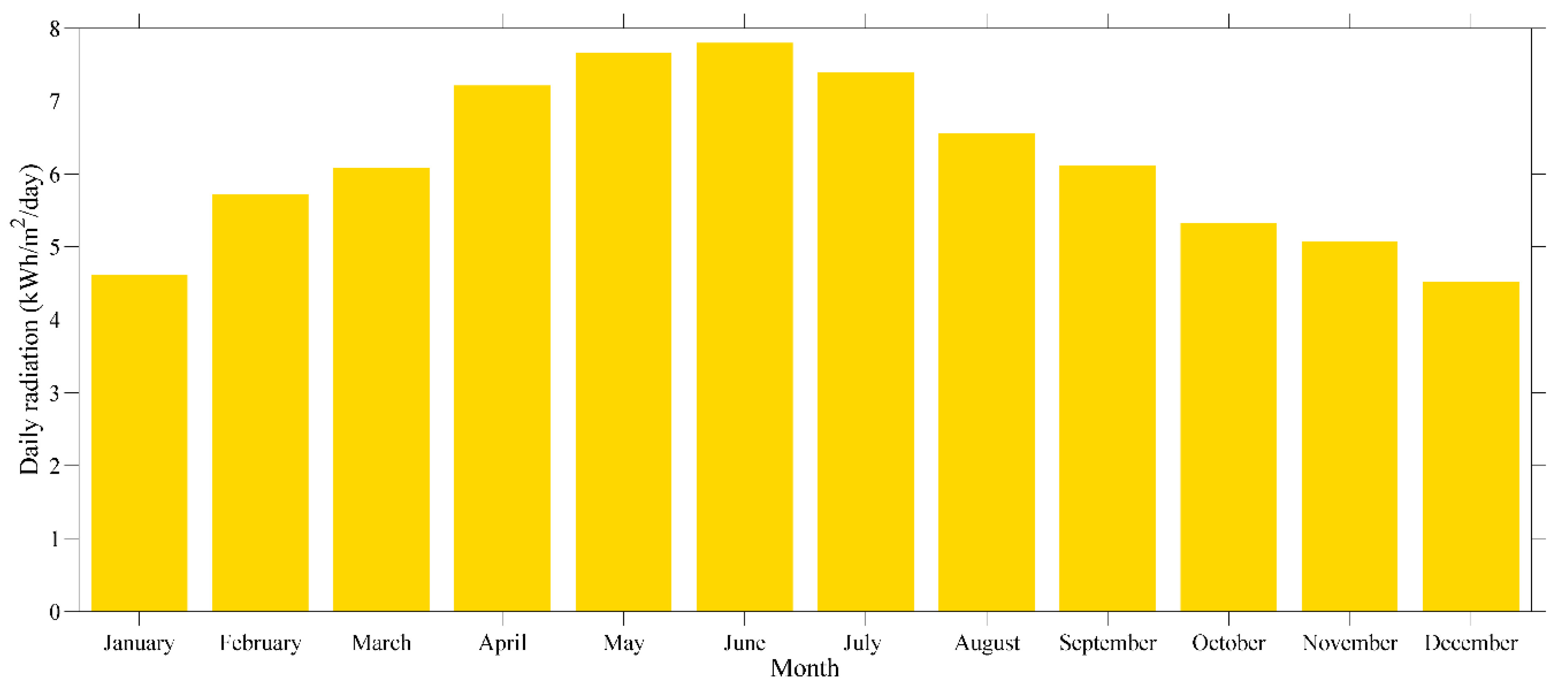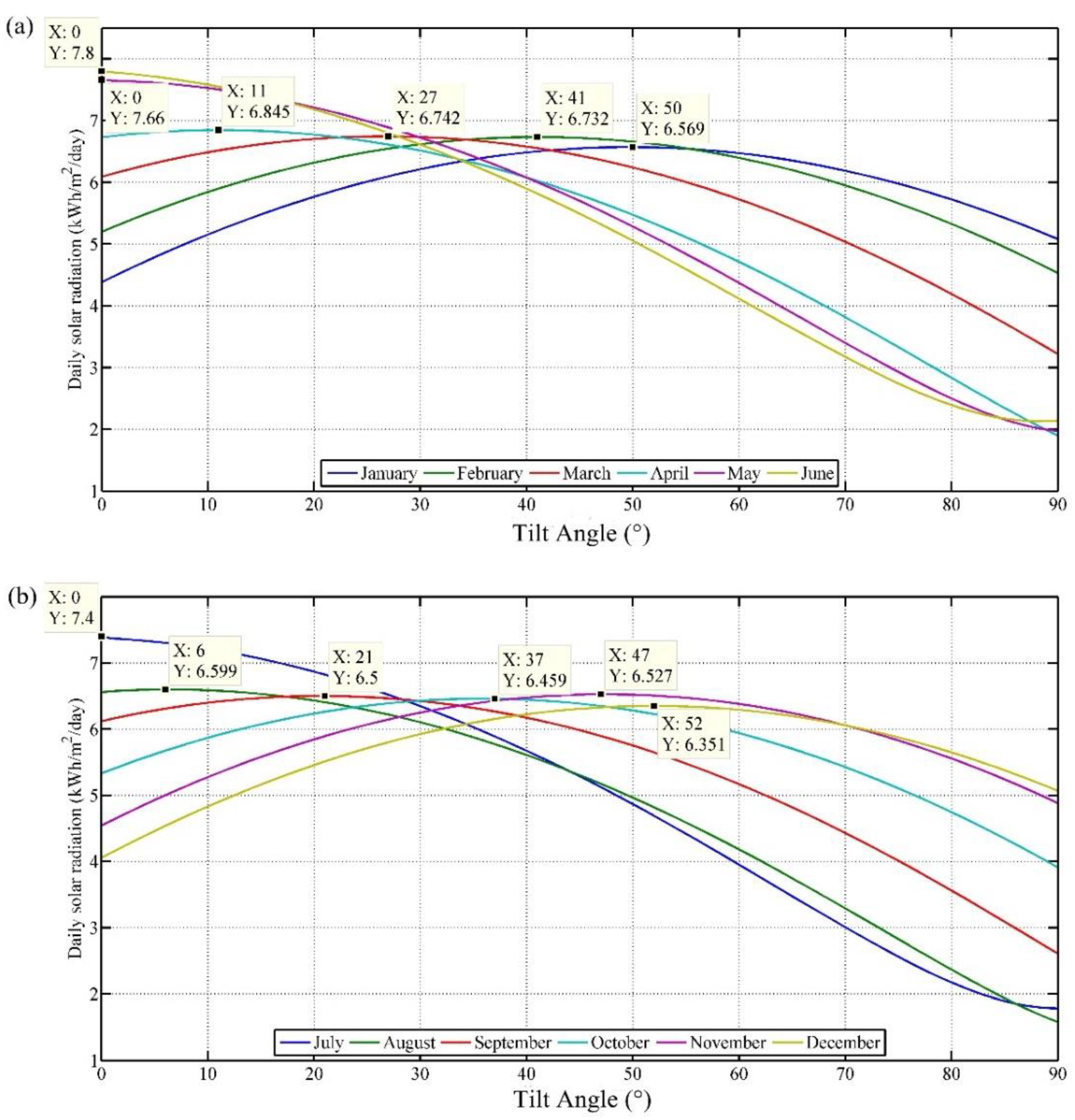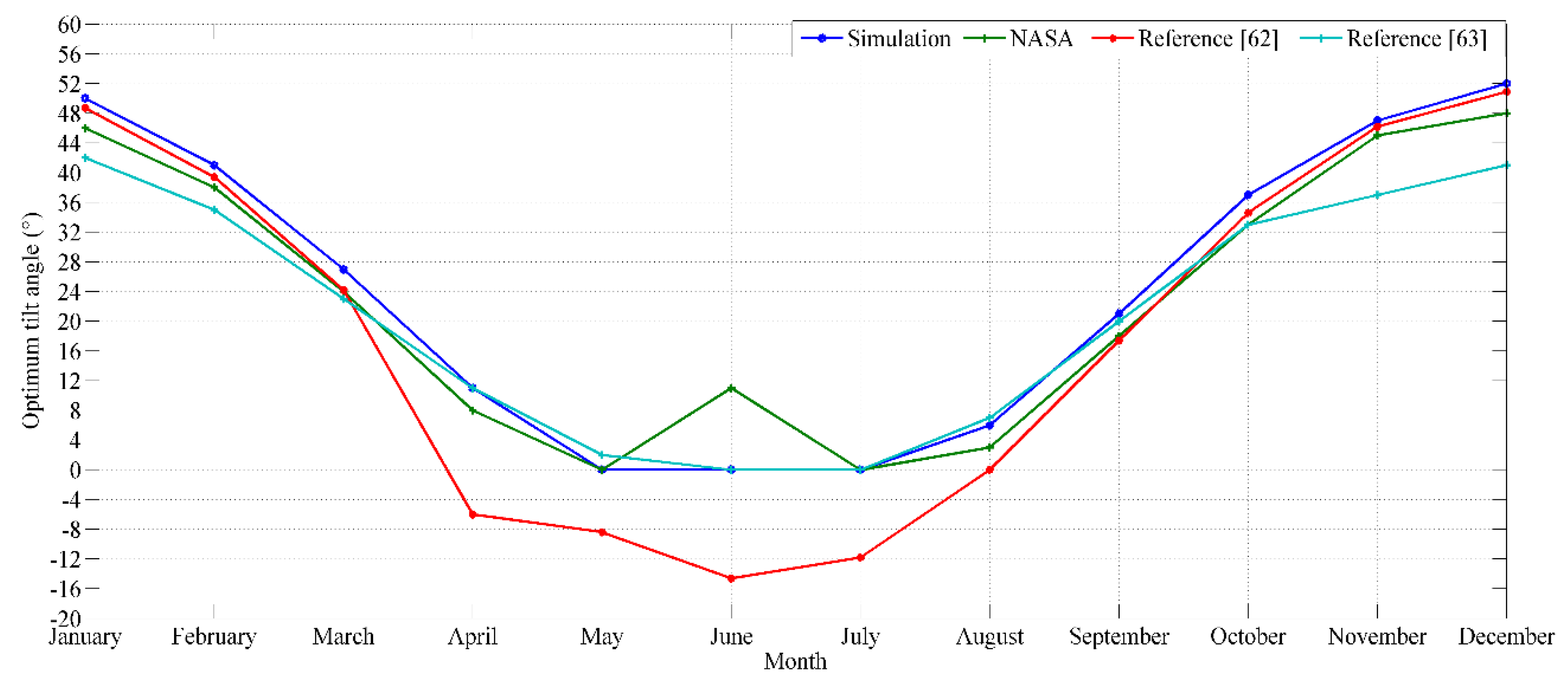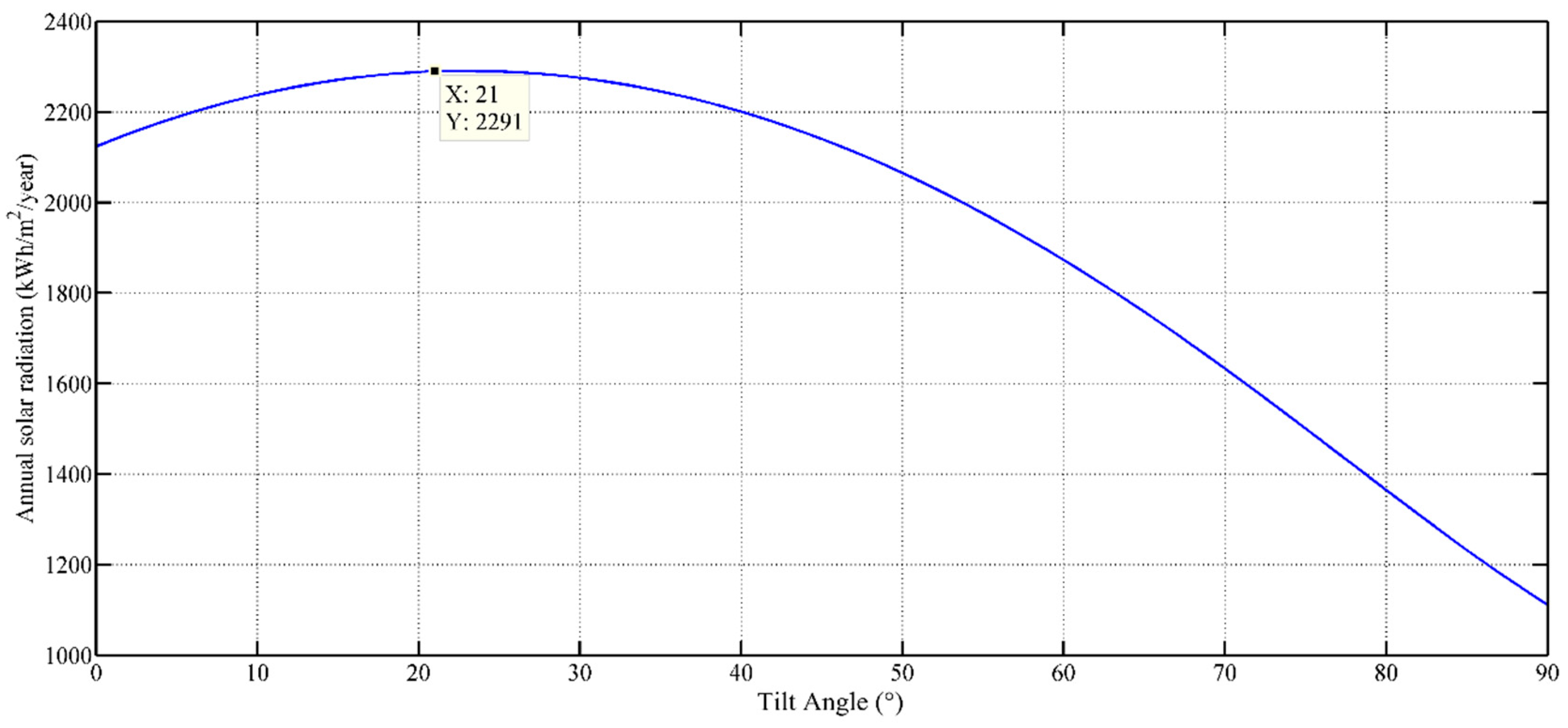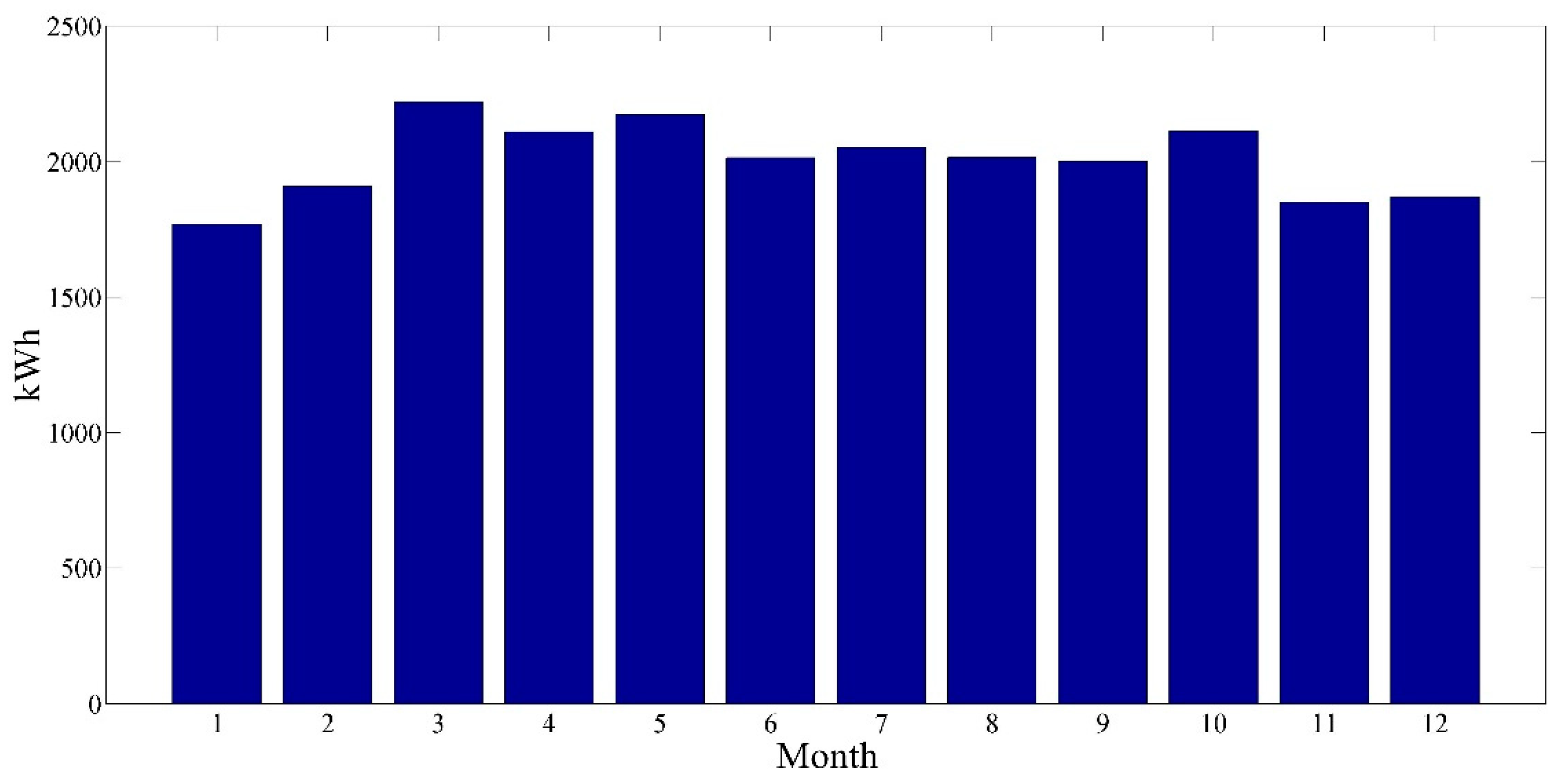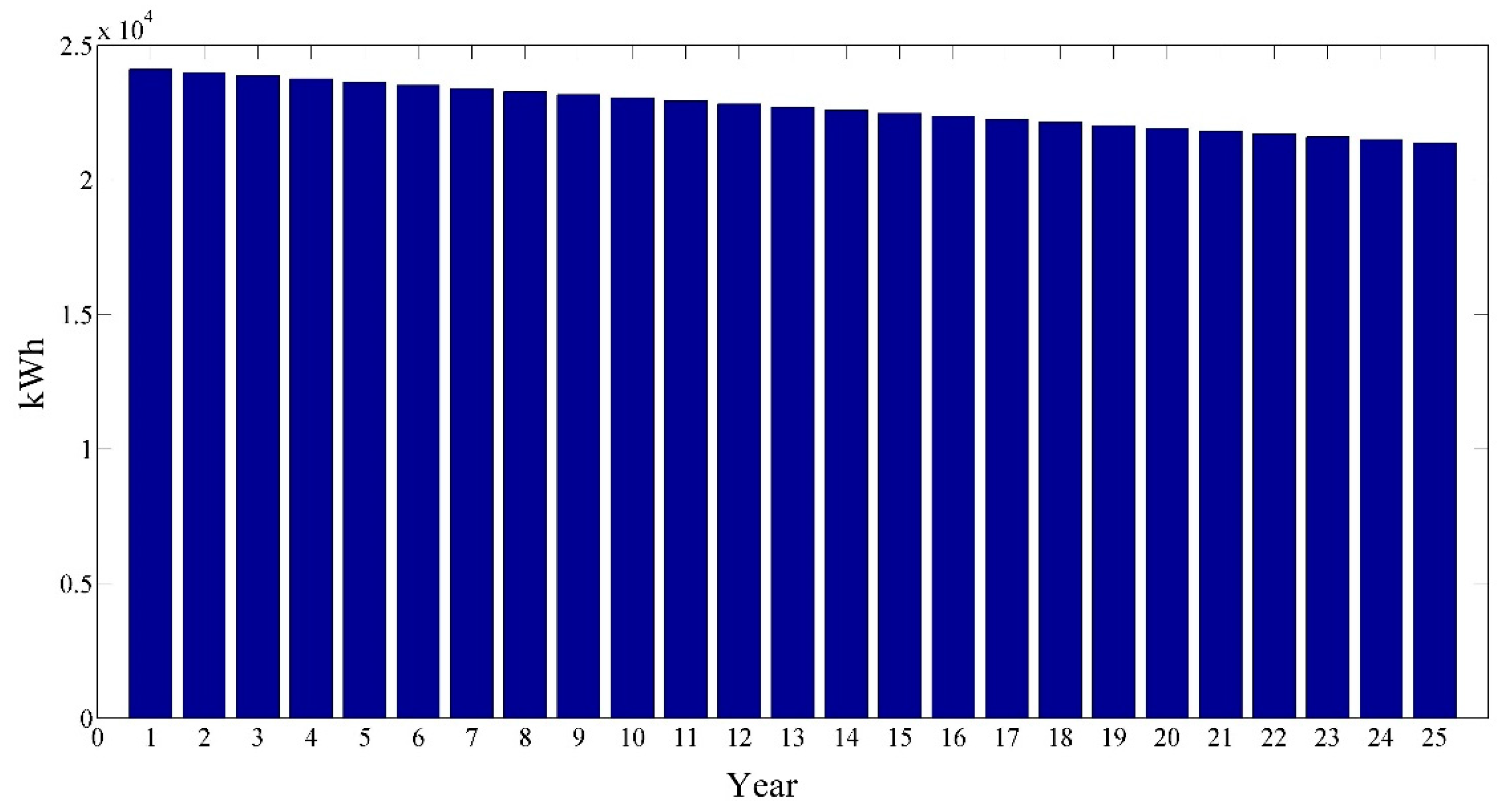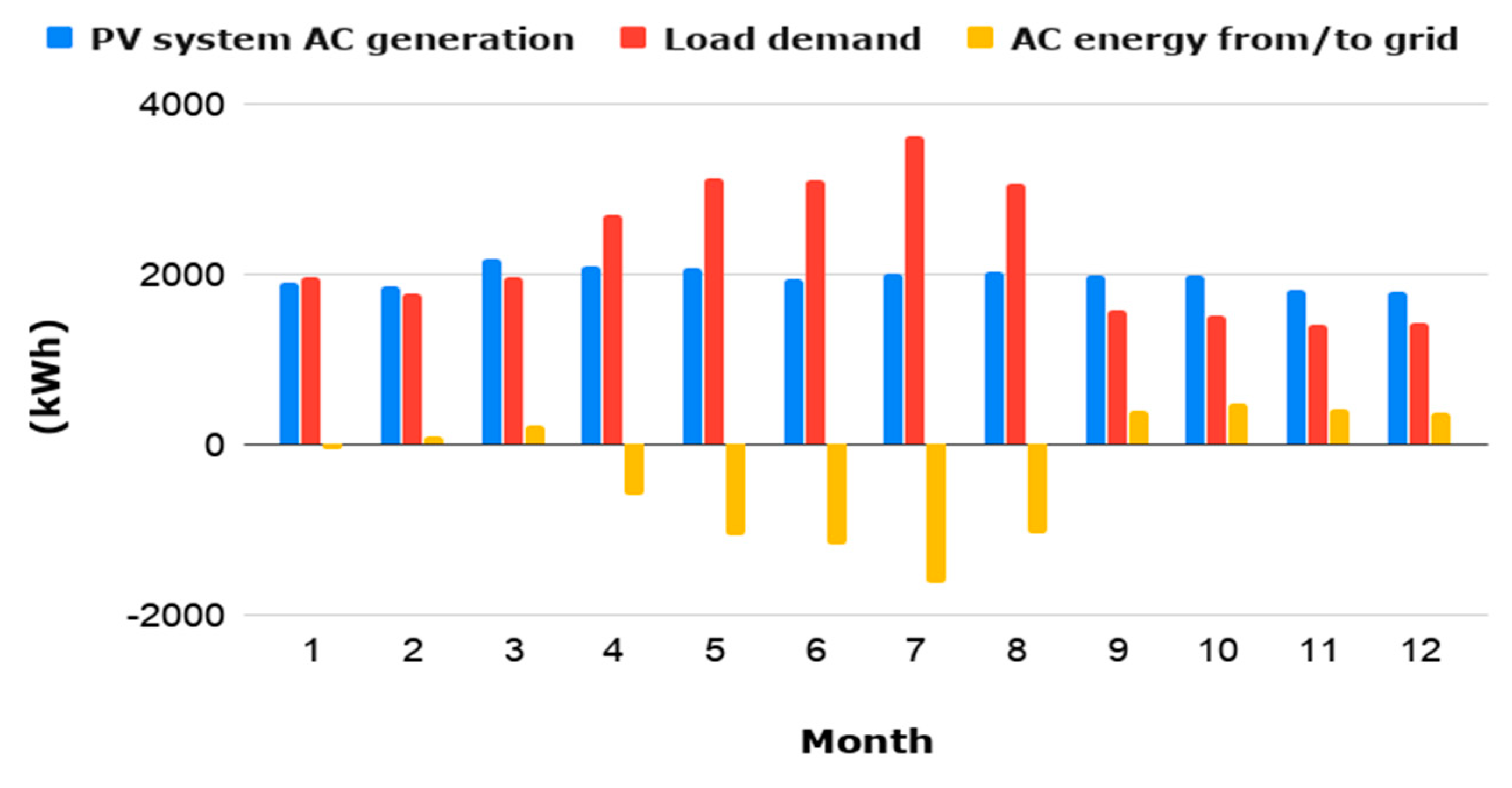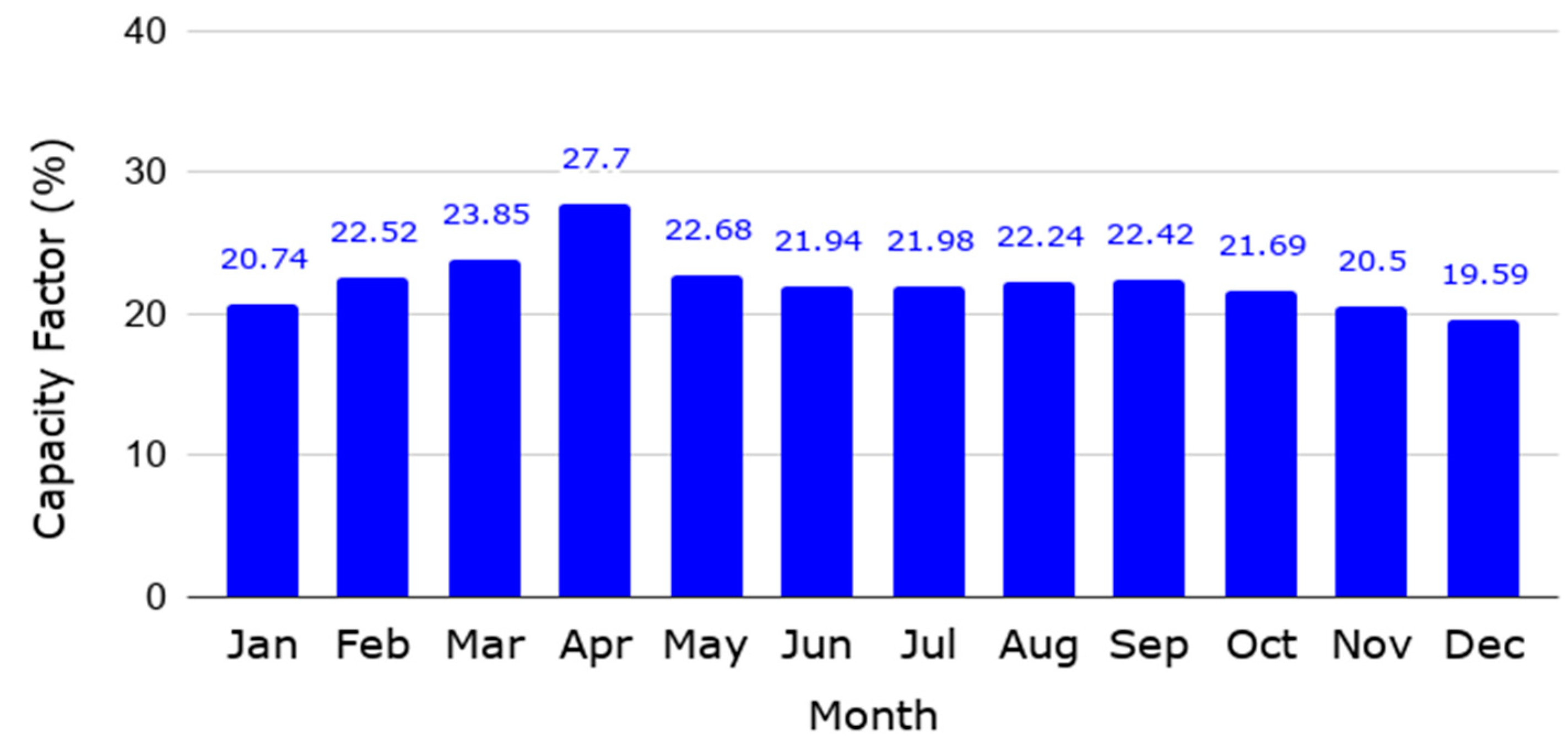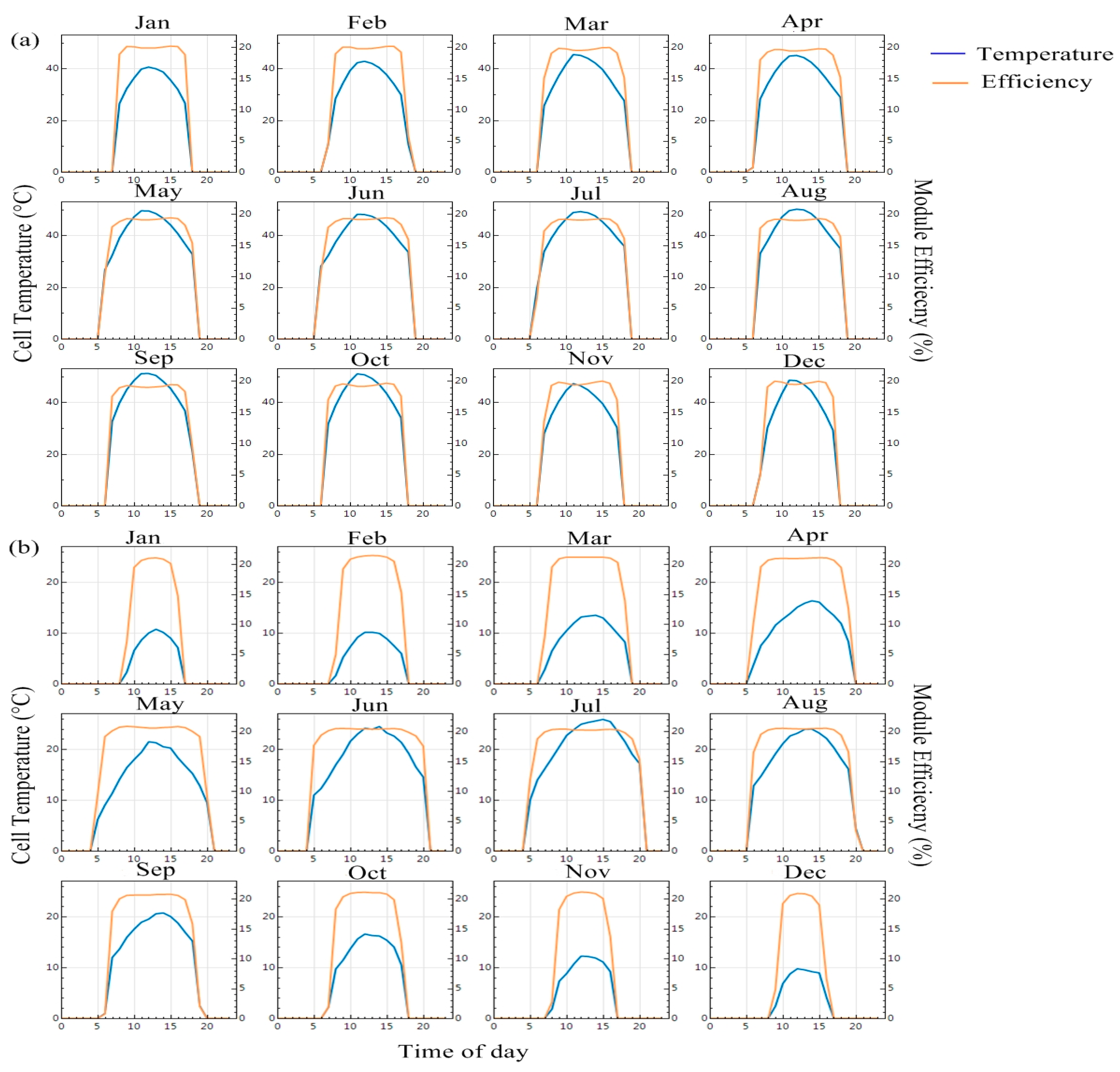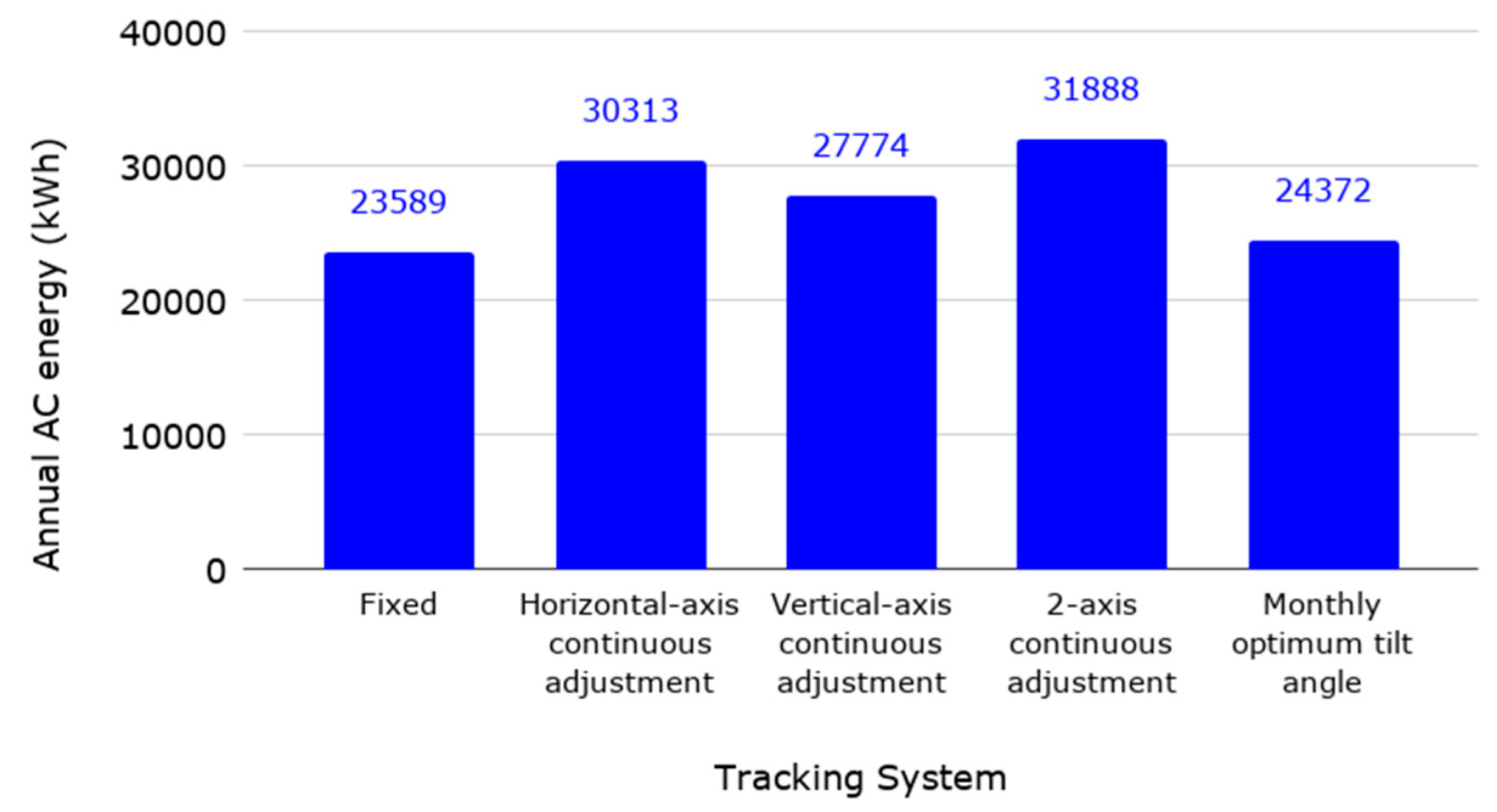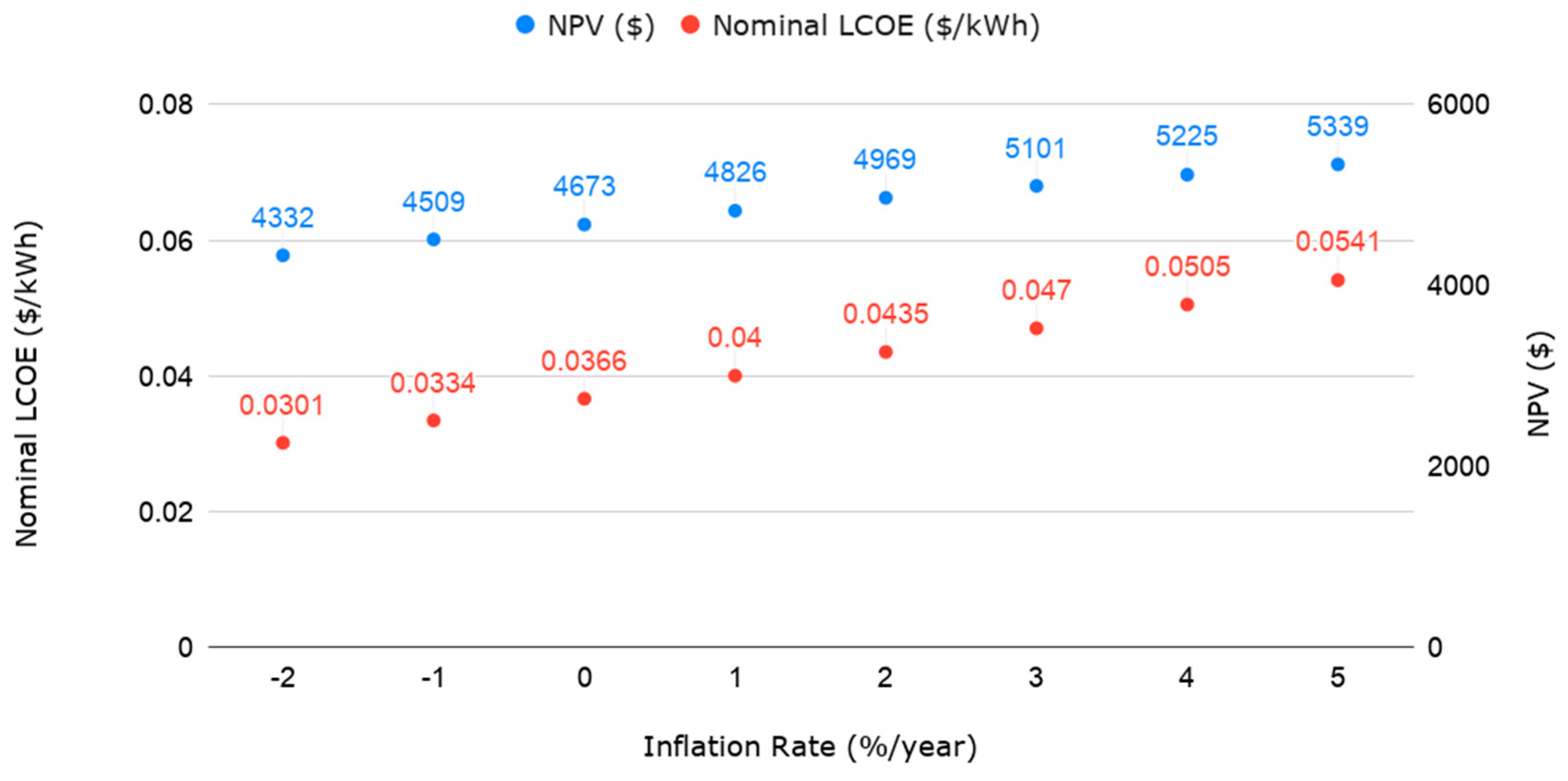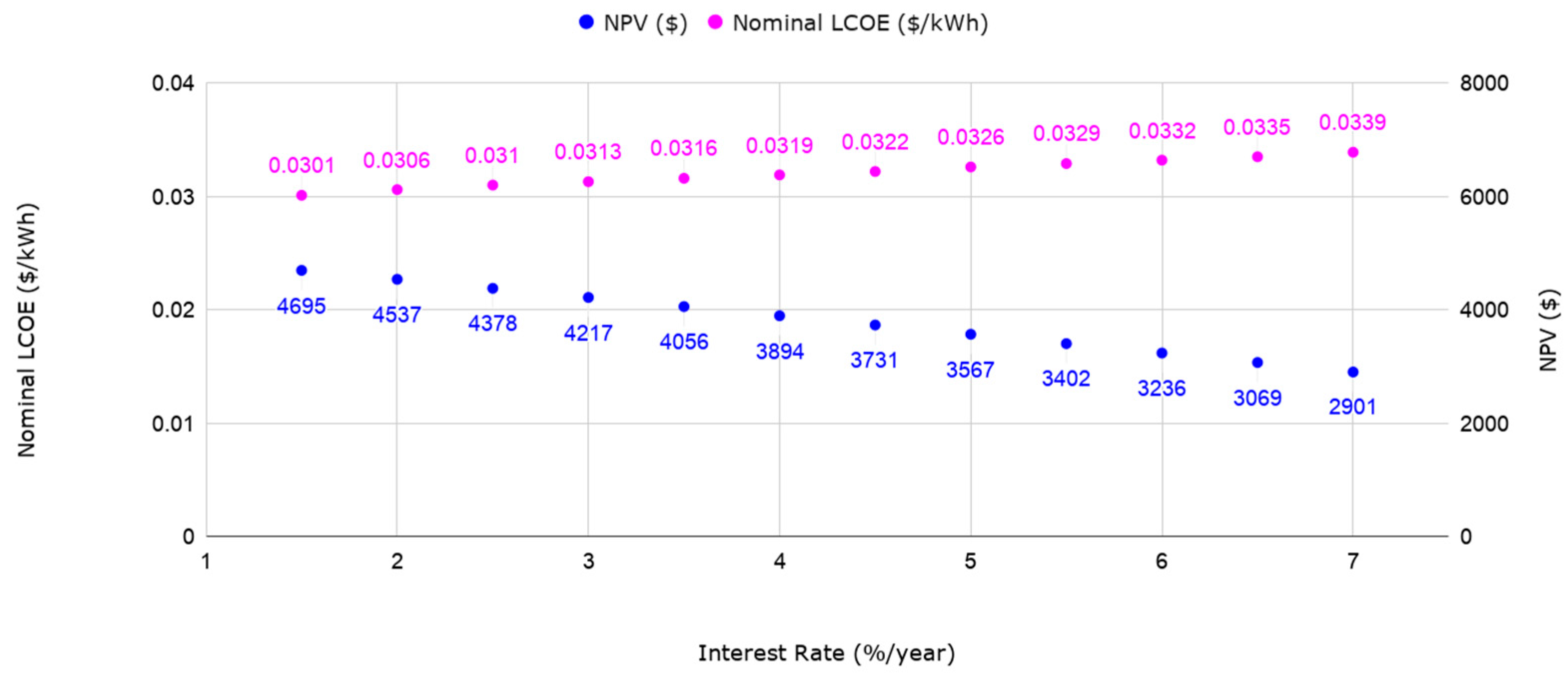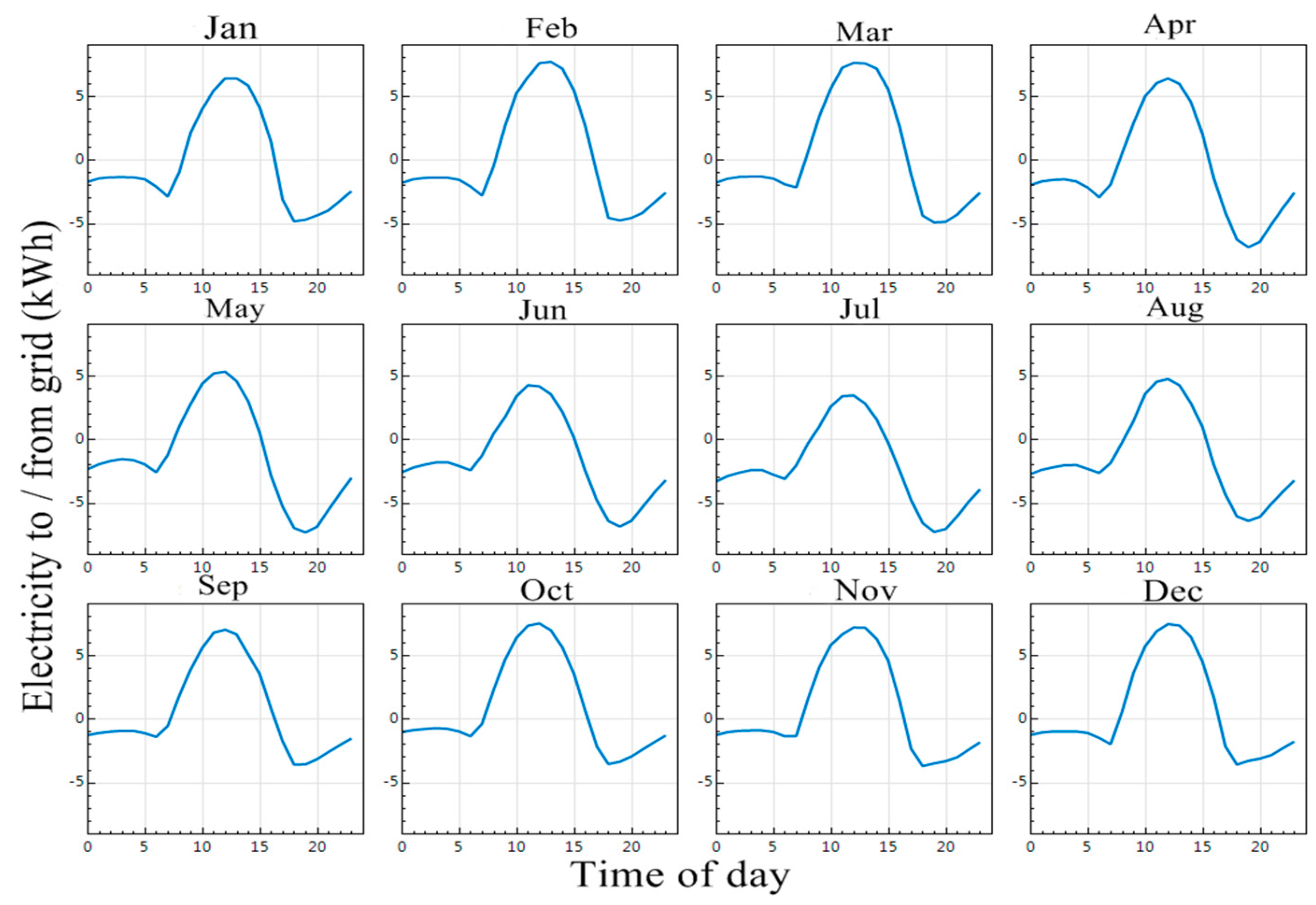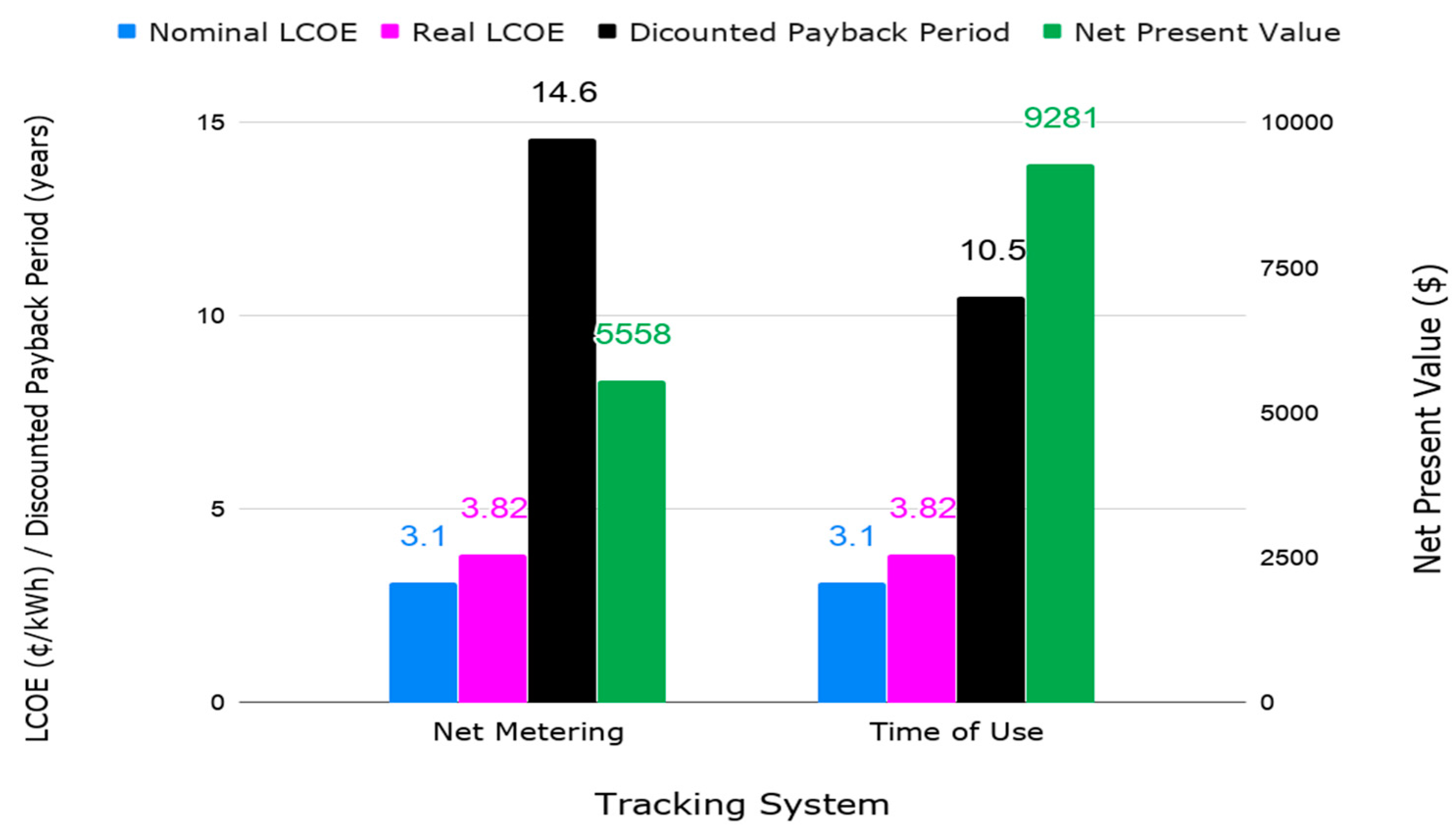1. Introduction
Conventional fuels utilized to generate electricity have negative potential impacts on the environment [
1]. In addition, reports show that fossil fuels and oil resources are constantly declining every year and will run out in the near future [
2,
3]. Hence, according to Vision 2030, Saudi Arabia aims to boost its renewable energy resources in its total energy share by producing nearly 9.5 GW of energy from sustainable energy sources by 2023, of which solar photovoltaic (PV) generation comprises a considerable portion [
4,
5,
6,
7]. The installed conventional power generation capacity in Saudi Arabia is the largest compared to other countries in the Middle East, with a total capacity of 88,685 MW of power generation in 2017. The average cost of electricity production in Saudi Arabia is 0.0544
$/kWh. Energy costs have been calculated based on the government-subsidized fuel price, which is much lower than the international average electricity price [
8]. With reference to the electricity demand in Saudi Arabia, the country has experienced drastic growth in recent years as a result of the continued expansion of both its population and industrial development. Saudi Arabia’s energy usage increased from roughly 296,648 GWh in 2016 to 298,439 GWh in 2017, with a growth rate of 6%, while the peak load demand increased from 32,000 MW in 2008 to 63,121 MW in 2017, with a 63.2% average growth rate [
9,
10]. According to an independent study, it is expected that the peak load will continue to increase to over 70,000 MW by 2020 [
11]. This figure of demand has been driven by population expansion, urbanization, higher levels of material comfort, and economic growth [
12].
The building sector is responsible for almost 80% of electrical energy consumption in the country, with over 50% attributed to residential buildings [
13]. Therefore, the presence of alternative energy solutions in the domestic sector is of the utmost importance. Solar energy is one of the best solutions to overcome the issue of electric energy demand growth [
14]. Since Saudi Arabia possesses a large potential for solar energy, a considerable share of its energy needs may be harvested from solar energy. Saudi Arabia’s high solar irradiation availability, significant rainless areas, and long daylight hours make th country among the most suitable countries for the utilization and deployment of solar energy resources on a large-scale basis. The annual average irradiation in the countries with highest radiation potential ranges between 100–200 W/m
2. Saudi Arabia, however, has an annual solar radiation reaching 250 W/m
2, outpacing many other countries. In addition, Saudi Arabia has the advantage of long average hours of sunshine per day (8.53 h), vast expanses of free lands, and a cloud-free atmosphere [
15]. These factors make Saudi Arabia a very favorable environment for the use of solar PV technologies.
Figure 1 shows the global horizontal solar irradiation in Saudi Arabia [
16].
Saudi Arabia began to apply solar energy in 1966. The King Abdullah City for Science and Technology was founded in 1977, and research and development in the field of solar energy technologies was among the most active research areas in the city. In 1980, the Kingdom of Saudi Arabia established the “Solar village”, the largest solar energy project at that time (350 kW), with the purpose of supplying three rural villages with electric power [
17]. Large-scale solar energy production in Saudi Arabia began in 2010 with the commission of a rooftop solar photovoltaic system with a total capacity of 2 MW on the roof of King Abdullah University of Science and Technology (KAUST). This project consisted of 9300 solar panels and covered an area of 11,600 m
2 of the roof. The annual production capacity of this project was about 3281 MW. In 2012, the world’s largest solar car parking at that time (10 MW) was established in Saudi Aramco’s headquarters in Dhahran. The carport’s integrated solar photovoltaic system occupies 4500 m
2 of the parking space. More than 120,000 Copper Indium Selenide photovoltaic modules were utilized over the parking territory to provide parking shades to deliver electrical power. The King Abdullah Petroleum Studies and Research Center (KAPSARC) project is the largest ground-mounted photovoltaic system in Saudi Arabia. It was commissioned in 2013 with a total capacity of 3.5 MW in Riyadh, Saudi Arabia. The project was constructed on a total area of 55,000 m
2, and a total of 12,684 photovoltaic modules were installed. The project produces 5800 MWh of solar electricity annually and thus reduces 4900 tons of CO
2 emissions. Implementing a ground-mounted photovoltaic system with an installed capacity of 5.4 MW was a part of the King Abdulaziz International Airport Development Project. The project was commissioned in 2013, over an area of 600,000 m
2, with an annual production of approximately 9.3 GWh [
18,
19,
20].
At present, residential scale solar PV systems contribute significantly to the total energy share. Developed countries (e.g., Germany) have developed encouraging regulations to expand the use of solar systems in buildings. Germany, having implemented a feed-in-tariff approach in the early 1990s, has established a large base of residential solar PV systems. The feed-in-tariff concept has been applied throughout the world in countries like the UK, the USA, Spain, Italy, and Japan, witnessing rapid expansion in their PV markets [
16].
Recently, Saudi Arabia has introduced regulations pertaining to small scale residential grid-connected PV systems for eligible consumers to encounter the issues associated with the high-power consumption peak load demand in the domestic sector. A net metering scheme has been proposed by the Electricity and Cogeneration Regulatory Authority (ECRA) to be implemented to bill the eligible customers who are installing grid-connected PV systems in Saudi Arabia. In the net metering scheme, the excess generation fed to the grid is rolled over to the next month’s bill, effectively reducing the billable kilowatt-hours in that month. Excess generation at the end of December is credited to the December electricity bill at the year-end sell rate, which is equivalent to the utility rate for purchased electricity [
21].
The grid-connected solar PV system is designed to operate alongside the utility power grid. However, a techno-economic viability investigation for this system is a substantial process needed to persuade individuals to turn to solar energy. Even though it is theoretically feasible to replace the present fossil fuel electricity infrastructure with renewable energy conversion facilities, such as solar PV systems, financial boundaries remain the essential obstacle to a renewably-powered society [
22]. As an off-grid solar PV system is to be incorporated with an energy storage system, battery packs are used for energy storage in territories without power grids. Nevertheless, integrating an energy storage system reflects a higher energy production cost [
23]. On the other hand, in grid-connected systems, the grid can be used as storage. A grid-connected PV system feeds the grid when it has extra energy production, and when the housing demand exceeds the produced energy, the shortage will be substituted from the grid [
24]. Significant studies have been carried out in order to design and analyze the techno-economic viability of residential-scale and utility-scale grid-connected solar PV systems by employing different simulation tools and carrying out experimental work.
Rehman et al. [
25] analyzed the technical, environmental, and economic feasibility of installing a 10 MW power plant at different sites in Saudi Arabia to select the most viable location. This study revealed that Bisha is the most suitable site for installing a 10 MW grid-connected PV (GCPV) system due to its long sunshine hours and high amount of solar irradiance. Thus, this system would eliminate 8182 tons of greenhouse gases every year. Makbul and Ayong [
26] presented a performance analysis of a potential PV system located in the western region of Saudi Arabia. This estimate was based on solar irradiance, while a stand-alone system with 85 MW capacity was analyzed. The study in [
27] reported a total energy yield of 1 MW over the lifetime of a proposed 42,978.9 MWh grid-connected PV system in the Qassim region, assuming a 1% annual energy yield reduction due to project degradation. The yield factor, capacity factor, and performance ratio were analyzed as technical performance indicators, while the levelized cost of energy and payback period were used as economic performance indicators. In [
28], a rooftop PV solar generation was studied. The author examined various design options to define the most feasible design for a rooftop PV system in the city of Majmaah, Riyadh province. The study concluded that the most feasible option from an economic point of view in Riyadh is a grid-connected system without battery storage. In [
29], Okello et al. carried out a comparative study between the real measurements and simulated performance of a 3.2 kWp GCPVS located at Nelson Mandela Metropolitan University, South Africa. The system supplies 5757 kWh to the local distribution network. The resulting performance ratio was found to be 84%, which is higher than the ratios of 74%, 81.5%, 67.4%, 70%, and 64.5% reported in Khatkar-Kalan (India) [
30], Dublin (Ireland) [
31], Crete (Greece) [
32], Karnataka (India) [
33], and Malaga (Spain) [
34], respectively. Pietruszko [
35] presented a 1 kWp rooftop-mounted GCPVS located in Warsaw, Poland. The annual energy production was 830 kWh, exceeding the simulation results. The performance ratio and efficiency were found to be between 60% and 80% and 4% and 5%, respectively. Milosavljević et al. [
36] presented a performance analysis study of a 2 kW GCPVS mounted on the roof of the building for the Faculty of Sciences and Mathematics in Niš, Serbia. Weather data were taken from 1 January 2013 to 1 January 2014. The performance ratio annual mean value and annual capacity factor with transmission integration were found to be 93.6% and 12.88%, respectively. The authors concluded that the connection of this system to the network is viable. El-Shimy [
37] investigated the economic and environmental feasibility of, and the most advisable site in which to install, a 10 MW GCPVS in Egypt. The author acquired metrological data for 29 studied sites in Egypt from the NASA renewable energy resource website. The results showed that the system installed at the Site of The Oasis of Kharaa was the most efficient in terms of productivity, greenhouse gas emissions, and economic profit.
Although most researchers focus on utility-scale grid-connected systems, some research endeavors, some research endeavors were dedicated to investigating residential systems. In [
38], Elieser et al. conducted a study to assess the technical, economic, and environmental aspects of a residential grid-connected PV system for the supply of household electricity load demand in Surabaya, Indonesia. The results showed that a 1 kW system can meet the basic electricity demand of a household in Surabaya. The authors in [
39] studied the technical options, operation, and economic assessment of a grid-connected PV system installed in a residential building in Kastoria, Greece. The study concluded that the successful and efficient collaboration between solar system industries, investors, and utilities can be achieved only after a long introduction period and intensive cooperation.
Since residential, grid-connected PV systems are interconnected with the distribution grid, positive and negative impacts on the distribution network are associated with this interconnection. Shalwala [
40] studied the impact of residential GCPV systems on the distribution network in Saudi Arabia. The outcomes revealed that, even under a wide penetration range of residential GCPV systems, a slight controllable voltage rise occurs in the distribution network. Shalwala [
41] presented the role of residential GCPV systems in peak load demand reduction. Shalwala’s findings emphasize the ability of such systems to relieve the distribution network and provide an almost constant load profile.
The literature review affords a solid background for this research by presenting numerous techno-economic case studies carried out in Saudi Arabia and worldwide. However, most of the previous studies focused on only a few performance indicators. This paper involves an economic and technical feasibility study on installing a grid-connected PV system in a typical residential unit in Jeddah, Saudi Arabia. The main objective of this investigation is to assess the techno-economic feasibility via a wide range of performance indices. These indicators include energy yield, yield factor, capacity factor, and performance ratio as technical indicators, while economic indicators involve the levelized cost of energy, net present value, internal rate of return, and payback period. This study covers tilt angle optimization, which is one of the most significant factors that determines the productivity of a solar PV system and is rarely discussed in techno-economic studies. A sensitivity analysis was also conducted to optimize the PV system configuration and determine the response of the performance indicators to input variation.
The following section presents the methodology and data used in this case study.
Section 3 analyzes the measured performance results and the effects of input variability on both technical and economic indicators. Finally,
Section 4 concludes the findings of the investigation.
4. Conclusions
Recently, Saudi Arabia has given more attention to renewable energy sources to gradually replace conventional energy conversion systems. In this regard, the government intends to encourage households to generate their own electricity by relying on renewable energy. Technically, photovoltaic power generation is the most applicable technique due to its stationary nature of operation and the high solar radiation potential in Saudi Arabia. In this paper, the techno-economic feasibility evaluation of a grid-connected solar PV system mounted on the rooftop of a residential building in Jeddah (21.4858° N, 39.1925° E), Saudi Arabia, is presented and analyzed. Several performance indicators, such as yield factors, net present value (NPV), internal rate of return (IRR), payback period, and a sensitivity analysis of the effects of the techno-economic parameters’ variation on system performance were considered for the assessment using the system advisor model (SAM), which is renewable energy modelling software.
The proposed PV system size is estimated to be 12.25 kWp of 35 mono-crystalline silicon modules, with a nominal power rating of 350 Wp per module, at 22% efficiency and with a 57 m2 total module area coupled with two inverters using a maximum of 10 kW of AC power. The system configuration includes five modules per string and seven parallel strings with a DC to AC ratio of 1.22. The lifetime of the PV modules is set at 25 years with a 0.5% degradation factor per year, while the inverter’s lifetime is set at 15 years, as stated in the manufacturer’s datasheets.
The technical results revealed the following:
The system’s total monthly energy production for the first year varied between 2173.25 kWh in March and 1785.49 kWh in December. The total system energy generated in the first year was 23,589 kWh, with an average energy production of 1965.72 kWh/month. The system’s lifetime total energy production was estimated to be 31,528,392.5 kWh, under the assumption of an annual reduction in energy yield due to an annual degradation of 0.5% in the output power of the PV modules. However, factors like cloudy weather in autumn and a short sunshine period and low solar irradiance in winter were found to affect the energy output in November and December, as well as in January and February, but high temperatures and soil losses due to dust accumulation did not have any appreciable effect on the energy yield in June.
The capacity factor (CF) of this system was found to be 22%, which is more reasonable than similar grid-connected systems in the GCC region, as found in the literature. The monthly capacity factor ranges between 23.85% in March and 19.59% in December.
The PV system’s annual performance ratio (PR) was estimated to be 78%. This was found to be low due to the high solar cell temperature at the site, which decreases solar cell efficiency.
Economic analysis resulted in the following findings:
The nominal and real LCOE is 0.0310 $/kWh and 0.0382 $/kWh. Both of these values are competitive with the electricity company tariff: 0.048 $/kWh for consumption up to 6000 kWh and 0.08 $/kWh for more than 6000 kWh.
The estimated NPV of the system over its lifetime is $4378, and its PBP is 14.6 years. Since the NPV is positive, the investor is earning money.
The key findings from the sensitivity analysis are the following:
It was found that a continuous two-axis tracking system outperforms other tracking systems in terms of productivity, with an additional 35.2% annual energy production relative to the system fixed at an optimum tilt angle. However, the costs of this tracking system outweigh its revenue. For example, this system has a negative NPV, and the values of LCOE exceed the electricity utility rates. Also, the optimum monthly adjustment tracking system results in an extended payback period, and the azimuth or vertical-axis tracking systems have no significant technical improvement. Thus, small-scale PV tracking systems were found not to be economically justifiable.
The interest rate and inflation rate were analyzed. It was found that Saudi Arabia’s inflation rate fluctuated from 3.5% to −1.8% between 2016 and 2019, and LCOE was also subjected to inflation rate variation. The LCOE exceeds the electricity utility rate up to 0.0505 $/kWh at a 4% inflation rate. The Saudi Arabian interest rate for 12-month maturity was in the range of 7% to 3% between 1997 and 2019, and the analysis proves that the investment is economically feasible for this range of interest rates.
The time-of-use billing (TOU) analysis revealed that the discounted payback period was decreased to nearly 10.5 years, while NPV was significantly increased to $9281, and LCOE remained unchanged. Hence, it can be inferred that the adoption of the TOU mechanism brings investors great economic benefit and, at the same time, can help in reducing the peak load demand.
In summary, it was found that 86.4% of the energy demand of a typical flat in the City of Jeddah can be generated by the proposed system. The energy yield, levelized cost of energy, and net present value indicate the satisfactory technical performance and economic viability of the system. A sensitivity analysis was performed to determine the optimum technical configuration and appropriate financial options that would obtain the maximum interest for households. The implementation of the solar PV tracking system shows that these tracking systems are technically feasible but not worthwhile from an economic point of view. Fluctuations in the economic parameters within the limits that Saudi Arabia has experienced do not pose risks to the economic viability of the project. Finally, the implementation of a time-of-use billing method can lead to significant economic benefits for investors.
This study can serve as a reference for similar solar energy projects, taking into account the differences in legislation and economic indicators for different countries. In addition, the installation cost of grid-connected solar photovoltaic (PV) systems has witnessed a rapid decline in recent years. Further investigations on the impact of the dynamic variations of solar electric power generation technology costs will be useful to help establish effective energy management schemes and policies that will orient energy production trends towards green and sustainable energy.
